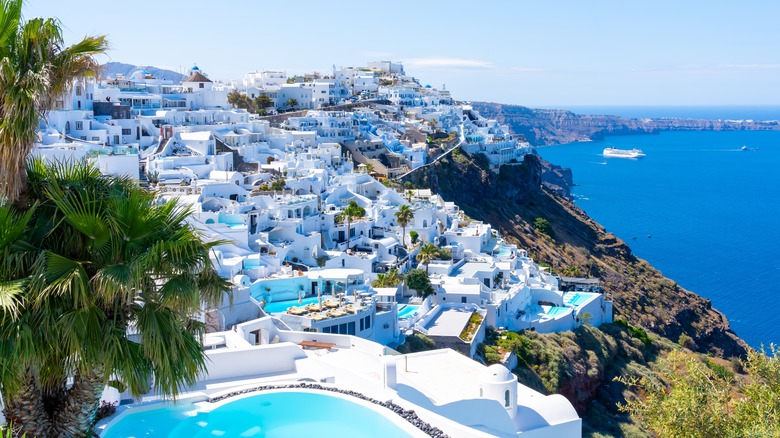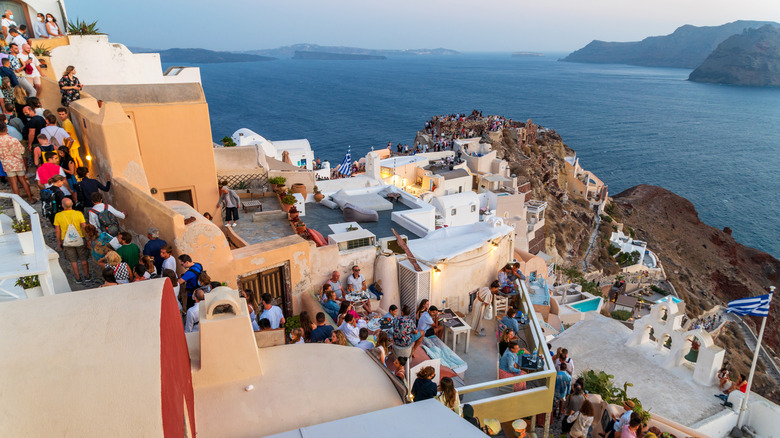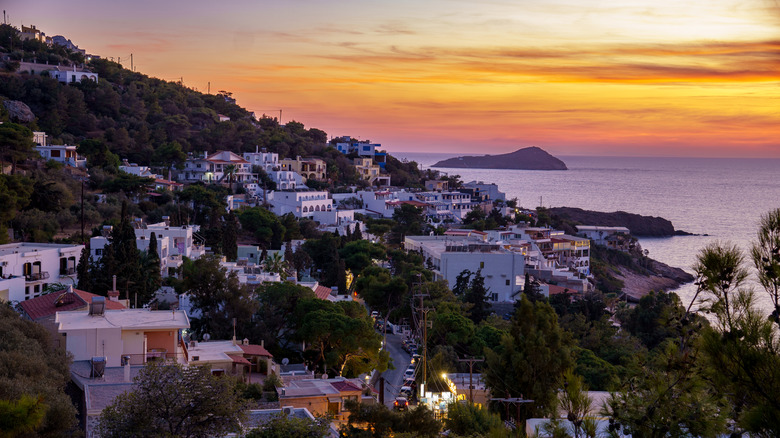Greece's Very Popular, Tourist-Loved Island Is Honestly The Country's Most Disappointing To Visit
The idea of "authenticity" gets tossed around a lot when considering vacation destinations. How "authentic" or "real" is a city, district, or tourist attraction? Does tourism define a destination to the point where it's stuffed full of fake tourist garbage (however we define that)? Is the destination so packed with tourists that it's impossible to enjoy and is losing its magic, like Barcelona and other overtouristed Spanish cities? All such questions come to bear on the Greek island of Santorini, a tourist favorite that's become sadly unbearable over time for a host of reasons related to too many tourists and too much kitsch.
Greece, in general, gets flooded with tourists every year. As a country that's one part beautiful Mediterranean destination, and one part nexus of supreme historical relevance, Greece received a walloping 40.7 million visitors in 2024, according to the Bank of Greece (via Greek Reporter). That's in a country with a population of around 10 million. Santorini, one of Greece's vast network of about 200 inhabited islands, gets about 3.4 million tourists per year. It's got a population of only 15,000. And Oia, the often-photographed, Instagram-beloved, whitewashed city with blue domes and tons of little pools, only has a speck of a population: Around 1,000.
Those numbers all but tell the entire story of Santorini. Yes, there are plenty of nice places to stay across all of Santorini's towns. But its principal attraction, Oia, is stuffed to the gills with shoulder-to-shoulder tourists buying novelty goods while taking endless pictures of themselves in dramatic poses. There's little in the way of shade, and while the sea is beautiful, Greece's natural land terrain (which is quite arid and rocky) really isn't. In short, it's one big tourist trap.
Inside Santorini's overtourism, uncomfortability, and inauthenticity
While we can't say with 100% certainty which Greek island is the "worst" to visit without some proper metrics, several islands come up again and again in conversations about the country's least enjoyable destinations. Unsurprisingly, those places are also among Greece's most widely-traveled, like Mykonos (1.5 million visitors every year) and Rhodes (a record-breaking 3.5 million in 2024, per the
). But overtourism, inauthenticity, and discomfort are especially pronounced in Santorini because, while many of its cities have whitewashed walls and narrow lanes, most visitors tends to pack into Oia (and maybe Fira).
Various firsthand accounts from visitors to Santorini tell the same tale. Users on Fodor's Travel bemoan the tourist-laden streets as well as the rocky, very non-green coastline. One thread on the Greece Travel subreddit describes the coastline as beautiful in its own way if you go in with the proper expectations, but says the entirety of the island has been greatly diminished over the past 15 years. Another thread on the same subreddit talks about tempering expectations and visiting during certain times of the year, like May, but admits that Santorini is overpriced and overcrowded. Santorini's rocky coast comes up again on The Lovely Escapist, which mentions its terrible, stony beaches and swarmed streets.
Bottom line: Yes, it's possible to enjoy anything if you go in with a certain mindset. But in Santorini, it's much harder than in other places. If you're intent on going, then by all means do so — provided you've set realistic expectations.
Explore Greece's many lesser-known alternatives to Santorini
While not all of Greece's 200 islands, plus the mainland, are excellent spots to visit, there are certainly plenty of alternatives to Santorini and the country's other overtouristed destinations. Milos in the Cyclades, is a good option for beach lovers, with a northern coast that's basically one long strip of powdery, whitish sand smoothed over rounded, water-worn stone formations. It's even got some of the same whitewashed buildings and staircases as Santorini. Even so, bear in mind that main towns like Plaka and Adamantas are completely saturated with hotels full of visitors no doubt looking to see the same sights.
Other options abound, such as Evia (also known as Euboea), Greece's second-largest island, which remains largely unknown despite being located just off the mainland and east of Athens. Evia offers the kind of gorgeously rugged, green-tufted, mountainous landscape that folks hope to find in Santorini. You could get a taste of the Mediterranean at one of Evia's northern beaches and then make your way inland through dense forest to a woodland waterfall like Drymonas Waterfalls.
On the other side of the Greek mainland, west of Athens. sits Kefalonia, a town-and-surf alternative to Santorini that sacrifices none of the natural found in locations like Evia. There are loads of beaches and quaint dining in small villages, and sites like Melissani Cave, accessible via boat and complete with its own lake and mini-forest inside (and a mythological origin tale of a spurned water nymph). Other offerings include ruins like the Ancient Acropolis of Sami and the Castle of St. George, two sites that add a nice historical touch to your time in Greece.


